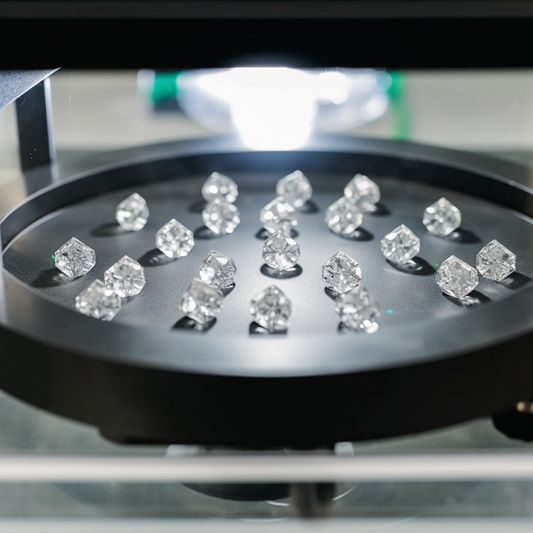Deciding on the right gemstone for an engagement ring or a beloved keepsake for a friend is tough. The traditional diamond has always been the ‘go-to’ option for discerning gemstone lovers, but new technology means there are alternatives.
The moissanite vs. lab diamond debate has raged for years. Although many people believe they are, in fact, the same thing, this couldn’t be further from the truth.
Let’s examine the difference between moissanite vs. lab-created diamond jewelry.
What is Moissanite?
Before delving into moissanite vs. lab-grown diamond jewelry, what is moissanite? One of the most common misconceptions is it’s just an artificial diamond. It’s not. There are differences.
Moissanite is a natural substance. It was initially discovered in a meteorite, which is why some call it “the gemstone of the stars.” The problem is it’s found in such low quantities in nature that jewelers have been forced to manufacture it in a lab.
Unlike diamonds, moissanite is not made from carbon but silicon carbide. Silicon carbide gives moissanite its unique gemstone properties.
What is a Lab-Grown Diamond?
Natural diamonds are pure carbon exposed to high pressures and heat deep within the earth. Lab-grown or synthetic diamonds are identical to the real thing. The only difference is the conditions where natural diamonds occur need to be simulated in a lab setting.
When comparing lab-created diamonds vs. moissanite, you may still think a natural diamond trumps them all. Truthfully, a lab diamond vs. moissanite is no worse in quality than a natural gemstone.
Unless someone tells you that a diamond was grown in a lab, it’s impossible to tell the difference between a natural and synthetic diamond.
Moissanite vs. Lab Grown Diamonds: What’s the Difference?
Is there any discernible difference when comparing lab-grown diamonds vs. moissanite? To the untrained eye, most people couldn’t tell the difference. Anyone with a remote interest in gemstones, or a piece of jewelry to compare, will be able to tell the difference instantly.
The two are distinct, and telling the difference between a lab-created diamond vs. moissanite is essential in making your purchasing decision.
Composition
Many love the look of moissanite because of its similarities with diamonds, but if you look with a discerning eye, you’ll soon spot the differences.
Diamonds are made from carbon exposed to high pressures. The composition of moissanite is entirely silicon carbide. Although containing carbon, moissanite’s compounds give it some unique properties.
Sparkle
People opt for moissanite rings vs. lab-created diamonds because of the difference in sparkle. Moissanite sparkles considerably more than a natural or synthetic diamond.
The moissanite gives off a colorful sparkle. The dispersion makes its sparkle look like miniature fireworks. However, the noticeability of the effect means most people prefer smaller moissanite stones.
Refraction
Are you concerned with how your jewelry catches the light? That’s what’s known as refraction.
Your standard diamond is singly reactive. When light refracts through the stone, you’ll see a single beam. Moissanite is doubly refractive. The little rays of light will appear doubled. Moissanite is more similar to sapphires and zircon in this sense.
Durability
The Moh’s hardness scale determines how strong a gemstone is. The highest rating available is a ten, assigned exclusively to the diamond.
Moissanite holds a rating of 9.25/10. In other words, moissanite is durable, tough, and can stand up against the challenges of the day. Your stone is more than capable of dealing with a busy lifestyle.
Color
Classic moissanite comes in colors of yellow, green, colorless, and nearly colorless. Diamonds, on the other hand, can be found in many colors. Although most people opt for the colorless diamond, a lab-grown diamond can conceivably be manufactured in almost any color at all.
However, advances in technology mean this debate between lab-grown diamond vs. moissanite is fast receding, as more and more moissanite colors become available.
Should You Choose Moissanite vs. Lab Diamonds?
A diamond lab-grown vs. moissanite has a lot in common. They bring tremendous sparkle, come in various cuts, and are both conflict-free and eco-friendly. These gemstones will never leave you with a guilty conscience.
Moissanites far surpass lab-grown diamonds in terms of sparkle, brilliance, and radiance. If you want a ring or necklace that catches the eye when you walk into any room, a moissanite piece is the best decision.
Although diamonds come with the bragging rights of owning a diamond, they’re still much more expensive. Moissanites cost a fraction of the price of both a mined diamond and a synthetic diamond.
Overall, it’s a matter of personal preference, but there are many reasons why moissanite has exploded in popularity.
Shop Gema&Co
Buying an affordable engagement ring doesn’t need hours of research. Let Gema&Co handle everything for you.
Browse our showcase for different cuts and styles. Alternatively, why not customize your own moissanite engagement ring from start to finish?
Find the ring you’ll fall in love with and shop with Gema&Co now.



